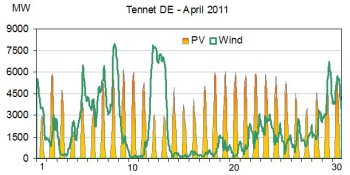State subsidies for solar energy cut down at short notice
The German federal ministers for environment and economy, Norbert Röttgen (CDU) and Philipp Rösler (FDP), have agreed on cutting down PV subsidies. For small PV systems (< 10 kW) the support will be reduced from 24.43 to 19.50 Euro cents per kWh (20%) and for the largest plants from 18 to 13.50 Euro cents (25%).
Prices of PV components have been falling, perhaps due to idle industrial capacity in China. Therefore PV investments have become gilt-edged and 7,500 MW new PV capacity was installed in Germany in 2011. This is three times the expected volume. The total installed capacity in Germany is now 25,000 MW.
According to the new rates the support will be reduced every month henceforward by 0.15 Euro cents per kWh.
The change has caused a fierce debate in Germany. Environmental organisations and affected businesses are protesting loudly. For instance the TV station ARD shows a large construction site with a farmer who recently decided to invest in a large PV facility. He feels deceived because it is impossible to stop the project.
Economics minister Philipp Rösler defends the intervention: "We must also think of the electricity customers and the consumers who are supposed to pay the subsidies for the solar energy. Electricity must also be affordable."
Increased regulating work
The impact of PV on the power system is another interesting aspect. PV has a very low load factor. For the TenneT area in Germany it was 0.13 in 2011 or 1,100 duration hours. When the PV production is added to the wind power the regulating work of the controllable power plants will increase considerably.

The maximum vertical load in the TenneT area was 14 GW in 2011 while the maximum combined wind and PV production was 13 GW.
It could be assumed to be an advantage that the PV production has a daily cycle, but unfortunately the daylight has gone during the evening peak load most of the year.
The 50.2 Hertz problem
German PV installations have been required to disconnect at a frequency of 50.2 Hz and above. In the beginning this function was unimportant, but now it has been realized that with an unstable frequency a simultaneous disconnection of up to 25 GW may have fatal consequences in large parts of Europe. Therefore about 315,000 large PV installations will be modified over a three years period for a total amount of money between 65 and 175 million Euro. After the change a disconnection is supposed to take place gradually between 50.2 Hz and 51.5 Hz. Normal production should automatically be resumed when normal frequency conditions have been detected.